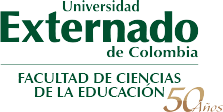13 de noviembre de 2020
It is time to become producers of contextualized knowledge
Jhonatan Vásquez-Guarnizo
The Colombian Ministry of Education (MEN) launched the now-familiar National Bilingual Programme (Programa Nacional de Bilingualismo, PNB) in 2004, which was designed to run from 2004 to 2019, and expected “to have citizens who are capable of communicating in English, with internationally comparable standards” (MEN, 2006, p. 6). However, it has been modified throughout the time. For instance, in 2012, PNB was renamed the Foreign Languages Competencies Development Programme (Proyecto de Fortalecimiento al Desarrollo de Competencias en Lenguas Extranjeras, PFDCLE) in order to make it more inclusive since Colombia has over 60 indigenous languages, along with Creole and Spanish, and part of the population is already bilingual (British Council, 2015).
Even though there have been important achievements, they have not yet allowed to attain the transformation in the process of teaching and learning English that Colombia requires (MEN, 2014, p. 4). Thus, the Colombian government outlined its plan for bilingualism once again in 2014, which was restructured under the name of National English Program (Programa Nacional de Inglés, PNI) and turned into a program they called Colombia, Very Well (Martínez, 2016).
This new program is planned to be carried out from 2015 to 2025 and it is an initiative that joins the other two programs [PNB and PFDCLE] to favor the improvement of the quality of education (MEN, 2014). In addition, it will focus on three components to be developed over the next 10 years. The first one entails strategies for teacher formation and design of pedagogical materials, the second one centers on the enhancement of quality, accompaniment and funding for higher education, and the third one has to do with articulation of the productive sector (El Universal, 2014).
Unfortunately, we have been under a blind and deaf Ministry of Education which have made decisions without even caring about our voices. Based on Kumaravadivelu (2012), “teaching should aim at a much nobler task of striving not only for educational advancement of learners but also for the personal transformation of learners and teachers” (p. 79). Consequently, it has become a need for EFL teachers to rethink the way English is taught as we are the ones who can transform education in our classrooms.
According to Rico (2012), “coursebooks should include activities where students can develop their ability of standing back from themselves and become aware of their cultural values, beliefs and perceptions that are different from the others” (p. 145). In this regard, Núñez-Pardo (2020) claims that “materials, in particular EFL textbooks, guide and enhance teaching and learning, raise students’ awareness of their learning process and of teachers’ pedagogical practice, and serve as mediations in sociocultural interactions among learners from diverse cultural worlds” (p. 18). In this manner, contextualized materials are required in the classrooms to transform our education through the creation of spaces where socio-cultural construction is present. Each context is diversely different; thence, my invitation is to normalize designing contextualized materials that fulfill our students’ needs.
Although English is widely spoken that it has been referred as a global language (Bogdan et al., 2017), we cannot leave aside the fact that English learning and teaching in Colombia have been permeated by a capitalism world where we replicate a decontextualized knowledge. From this perspective, it is time to “critically undertake the scholarly activity of developing ELT materials by creating contextualized ones that respond to the local needs, interests, and life experiences of the learners in their own context” (Núñez-Pardo, 2020, p. 23). Undoubtedly, we need to stop being consumers and become producers of contextualized knowledge.
___________________
References
Bogdan, D. Barbu, C., & Perez, F. (2017). English through Art – Developing English competences through Art-oriented activities in an ICT-based environment. http://arteducation.eu/EnglishThroughArt.pdf
British Council (2015). English in Colombia: An examination of policy, perceptions and influencing factors. http://obiret-iesalc.udg.mx/sites/default/files/publicaciones/45._english_in_colombia_-_british_council.pdf
El Universal (2014, July 15th). Mineducación anuncia ‘Colombia Very Well, estrategia nacional de bilingüismo. El Universal. https://www.eluniversal.com.co/educacion/mineducacion-anuncia-colombia-very-well-estrategia-nacional-de-bilinguismo-164634-JXEU258203
Kumaravadivelu, B. (2012). Language teacher education for a global society. A modular model for knowing, analyzing, recognizing, doing, and seeing. Routledge.
Martínez, S. (2016). Bilingualism in Colombia Higher Education. Enletawa Journal, 9 (2), 91-108. https://revistas.uptc.edu.co/index.php/enletawa_journal/article/view/7547
Ministerio de Educación Nacional (MEN) (2006). Estándares básicos de competencias en lenguas extranjeras. https://redes.colombiaaprende.edu.co/ntg/men/archivos/Referentes_Calidad/Estandares_basicos_de_competencias/Estandares_Basicos_Competencia_en_Lenguas_Extranjeras_%20Ingles.pdf
Ministerio de Educación Nacional (MEN) (2014). Programa Nacional de Inglés. Colombia, Very Well. https://www.ucn.edu.co/institucion/sala-prensa/noticias/Documents/2014/Documento%20PROGRAMA%20NACIONAL%20DE%20INGL%C3%89S%202015-2025.pdf
Núñez-Pardo, A. (2020). A Critical Reflection on Developing and Implementing In-house EFL Textbooks. Revista Papeles, 11(21), 11-31. http://revistas.uan.edu.co/index.php/papeles/article/view/869
Rico, C. (2012). Language teaching materials as mediators for ICC development: A challenge for materials developers. Signo y Pensamiento, 30(60), 130- 154. http://www.scielo.org.co/pdf/signo/v31n60/v31n60a10.pdf


